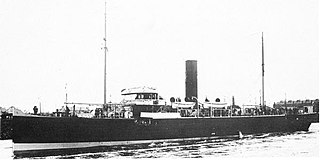
Q-ships, also known as Q-boats, decoy vessels, special service ships, or mystery ships, were heavily armed merchant ships with concealed weaponry, designed to lure submarines into making surface attacks. This gave Q-ships the chance to open fire and sink them. The use of Q-ships contributed to the abandonment of cruiser rules restricting attacks on unarmed merchant ships and to the shift to unrestricted submarine warfare in the 20th century.

An armed merchantman is a merchant ship equipped with guns, usually for defensive purposes, either by design or after the fact. In the days of sail, piracy and privateers, many merchantmen would be routinely armed, especially those engaging in long distance and high value trade.

HMS Good Hope was one of four Drake-class armoured cruisers built for the Royal Navy around 1900; she was originally named Africa, but was renamed before she was launched. She became flagship of the 1st Cruiser Squadron of the Atlantic Fleet in 1906, and was the flagship of the 2nd Cruiser Squadron in 1908. She was reduced to reserve in 1913, but was recommissioned in mid-1914.

A warship or combatant ship is a naval ship that is built and primarily intended for naval warfare. Usually they belong to the armed forces of a state. As well as being armed, warships are designed to withstand damage and are usually faster and more maneuverable than merchant ships. Unlike a merchant ship, which carries cargo, a warship typically carries only weapons, ammunition and supplies for its crew. Warships usually belong to a navy, though they have also been operated by individuals, cooperatives and corporations.

The Royal Naval Reserve (RNR) is one of the two volunteer reserve forces of the Royal Navy in the United Kingdom. Together with the Royal Marines Reserve, they form the Maritime Reserve. The present RNR was formed by merging the original Royal Naval Reserve, created in 1859, and the Royal Naval Volunteer Reserve (RNVR), created in 1903. The Royal Naval Reserve has seen action in World War I, World War II, the Iraq War, and War in Afghanistan.
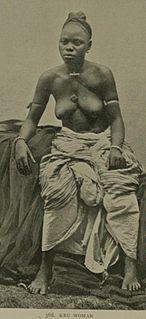
The Kru, Kroo, Krou or Kuru are a West African ethnic group who are indigenous to western Ivory Coast and eastern Liberia. They migrated and settled along various points of the West African coast, notably Freetown, Sierra Leone, but also the Ivorian and Nigerian coasts. The Kru people are a large ethnic group that is made up of several sub-ethnic groups in Liberia and Ivory Coast. These tribes include Bété, Bassa, Krumen, Guéré, Grebo, Klao, Krahn people and, Jabo people. The kru people were more valuable as traders and sailors on slave ships than as slave labor. To ensure their status as “freemen,” they initiated the practice of tattooing their foreheads and the bridge of their nose with indigo dye to distinguish them from slave labor.

Commodore Augustus Willington Shelton Agar, was a Royal Navy officer in both the First and the Second World Wars. He was a recipient of the Victoria Cross, the highest award for gallantry in the face of the enemy that can be awarded to British and Commonwealth forces, for sinking a Soviet cruiser during the Russian Civil War.

HMS London was a two-decker 90-gun second-rate ship of the line of the Royal Navy, launched on 28 September 1840 at Chatham Dockyard.

Bagamoyo, is a historic coastal town founded at the end of the 18th century, though it is an extension of a much older Swahili settlement, Kaole. It was chosen as the capital of German East Africa by the German colonial administration and it became one of the most important trading ports for the Germans along the East African coast along the west of the Indian Ocean in the late 19th and early 20th century. Today, it is the capital of the Bagamoyo District in Pwani Region. In 2011, the town had 82,578 inhabitants.

The Anglo-Zanzibar War was a military conflict fought between the United Kingdom and the Zanzibar Sultanate on 27 August 1896. The conflict lasted between 38 and 45 minutes, marking it as the shortest recorded war in history. The immediate cause of the war was the death of the pro-British Sultan Hamad bin Thuwaini on 25 August 1896 and the subsequent succession of Sultan Khalid bin Barghash. The British authorities preferred Hamoud bin Mohammed, who was more favourable to British interests, as sultan. In the agreement of 14 June 1890 instituting a British protectorate over Zanzibar, a candidate for accession to the sultanate should obtain the permission of the British consul, and Khalid had not fulfilled this requirement. The British considered this a casus belli and sent an ultimatum to Khalid demanding that he order his forces to stand down and leave the palace. In response, Khalid called up his palace guard and barricaded himself inside the palace.

HMS Manica was a merchant steamship that was built in England in 1901 and was scrapped in Japan in 1931. She was built as a dry cargo ship but spent the latter part of her career as an oil tanker.

The Krumen is an ethnic group living mostly along the coast of Liberia and Côte d’Ivoire. Their numbers were estimated to be 48,300 in 1993, of which 28,300 were in Côte d’Ivoire. They are a subgroup of the Grebo and speak the Krumen language.

The East Indies Station was a formation and command of the British Royal Navy. Created in 1744 by the Admiralty, it was under the command of the Commander-in-Chief, East Indies.
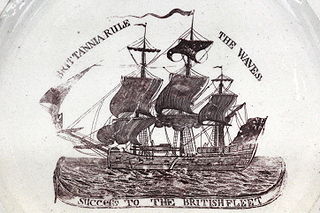
The Maritime history of the United Kingdom involves events including shipping, ports, navigation, and seamen, as well as marine sciences, exploration, trade, and maritime themes in the arts from the creation of the kingdom of Great Britain as a united, sovereign state, on 1 May 1707 in accordance with the Treaty of Union, signed on 22 July 1706. Until the advent of air transport and the creation of the Channel Tunnel, marine transport was the only way of reaching the British Isles. For this reason, maritime trade and naval power have always had great importance.

HMS Philomel, later HMNZS Philomel, was a Pearl-class cruiser. She was the fifth ship of that name and served with the Royal Navy. After her commissioning in 1890, she served on the Cape of Good Hope Station and later with the Mediterranean Fleet.
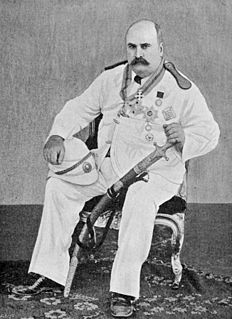
Sir Lloyd William Mathews, was a British naval officer, politician and abolitionist. Mathews joined the Royal Navy as a cadet at the age of 13 and progressed through the ranks to lieutenant. He was involved with the Third Anglo-Ashanti War of 1873–4, afterwards being stationed in East Africa for the suppression of the slave trade. In 1877 he was seconded from the navy to Sultan Barghash of Zanzibar in order to form a European-style army; he would remain in the employment of the government of Zanzibar for the rest of his life. His army quickly reached 6,300 men and was used in several expeditions to suppress the slave trade and rebellions against the Zanzibar government.

The Battle of Zanzibar was an encounter between the German Kaiserliche Marine and the British Royal Navy early in the First World War. While taking on coal in the delta of the Rufiji River in German East Africa, the German cruiser SMS Königsberg learned that a British cruiser, HMS Pegasus, which had been part of the Royal Navy's Cape Squadron sent to counter Königsberg, had put in at Zanzibar for repairs. Königsberg's captain, Commander Max Looff, decided to attack Pegasus while she was in port.
HMS Helmuth was a German tug that the Royal Navy captured at the beginning of World War I and armed as a picket boat. She served in the East African campaign including the battles of Zanzibar and Tanga, she survived a German attack at Dar es Salaam, and took part in blockading SMS Königsberg in the Rujifi Delta. In 1916 she took part in an amphibious assault on the coastal town of Bagamoyo.

During the First World War, the Commander-in-Chief at the Cape, Rear Admiral Herbert King-Hall, expended much effort to destroy the elusive German light cruiser Königsberg.
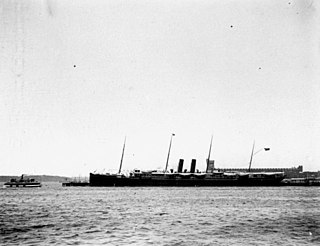
SS Himalaya was a P&O steam ocean liner that was built in Scotland in 1892 and scrapped in Germany in 1922. She operated scheduled services between England and Australia until 1908, and then to and from Japan until 1914.

















